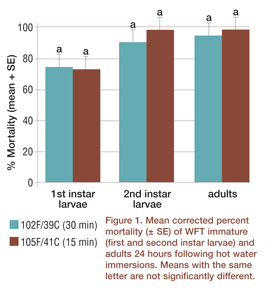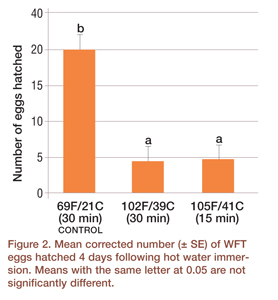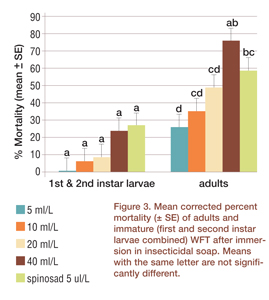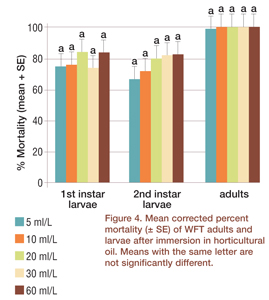8/24/2010
What’s the Best Thrips Defense?
Wendy Romero, Cynthia Scott-Dupree, Graeme Murphy, Theo Blom & Ron Harris

Western flower thrips (WFT) (
Frankiniella occidentalis [Pergande]) are, without a doubt, a major concern in Ontario floriculture greenhouses. Once they have become established in the greenhouse, WFT are extremely difficult to control. They can develop resistance easily to pesticides and, as a result, chemical efforts are often ineffective. Even if they are effective, these chemicals can have a negative impact on biological control agents, which are used in many Ontario greenhouses.
Currently, attention has been focused on controlling thrips that may be coming in on imported cuttings. There are several concerns: first, the influx of what could potentially be large numbers of thrips every week places constant pressure on any control program; second, if these thrips are insecticide-resistant, it removes one control option that growers have available to them; and finally, new thrips species may be introduced in this way. Using reduced-risk control methods would permit growers to establish thrips-free and insecticide residue-free cuttings from the outset, thus ensuring ongoing greenhouse biological control programs are not affected negatively.
First, we determine whether treatments were phytotoxic to cuttings. Chrysanthemum cuttings (Sunny Shasta) were immersed in hot water at various temperatures (95F to 109F/35C to 43C) for different immersion periods (5 to 60 minutes) and transferred to a cooling bath (69F/21C) immediately after for 1 minute. For the reduced-risk insecticides, cuttings were immersed for 1 minute in different concentrations of insecticidal soap (5 to 40 ml/L) or horticultural oil (5 to 60 ml/L). After immersion, cuttings were stuck in Oas

is for rooting using overhead misting.
Phytotoxicity was evaluated 20 days after immersion based on survival, number of roots per plant and height of cuttings. Hot water treatments at 95F (35C) for 15, 30, 45 and 60 minutes; 102F (39C) for 15 and 30 minutes; and, 105F (41C) for 5 and 15 minutes were not phytotoxic to cuttings. Insecticidal soap treatments (5, 10, 20 and 40 ml/L) and oil treatments (5, 10, 20 and 30 m/L) also were not phytotoxic to cuttings.
Second, treatments that were not phytotoxic were tested for their effectiveness in controlling WFT. Larvae and adults of WFT were immersed in hot water, insecticidal soap or horticultural oil inside a vented Petri dish. Mortality was assessed 24 hours after immersion. In addition, spinosad (Success 480 SC) was tested as an immersion treatment at the registered label rate of 0.05ml/L (50ml/1000 L) for foliar application against WFT in greenhouse ornamentals. Treatments needed to provide more than 80% mortality to be considered feasible for use in an IPM program.
Hot water
High mortality (>80%) of second instar larvae and adult WFT was obtained at 102F (39C) for 30 minutes or 105F (41C) for 15 minutes for hot water immersion treatments (Figure 1). Furthermore, a significant reduction in number of eggs was achieved with both treatments compared to the control (Figure 2).
Insecticidal  soap, spinosad
soap, spinosad
Insecticidal soap treatments and spinosad at the recommended rate resulted in less than 30% mortality of larvae and adult WFT (Figure 3). The 40 ml/L treatment of insecticidal soap provided the highest mortality of adult WFT of all the treatments at approximately 75%. The spinosad treatment resulted in approximately 58% adult WFT mortality. The results indicate that neither insecticidal soap nor spinosad provide the required level of control of WFT on chrysanthemum cuttings in an IPM program.
Horticultural oil
All horticultural oil treatments resulted in 100% mortality of WFT adults and 64% to 82% mortality of first and second instar larvae (Figure 4). Currently, horticultural oil is not registered for use in the greenhouse in Canada (it’s currently registered for use against scale insects, mealybugs, whitefly larvae and other nursery and landscape pests), but based on these results, it looks to be a promising reduced-risk insecticide for control for larvae and adult WFT on chrysanthemum cuttings. [
Please note: Horticultural oil IS registered for use in the U.S.]
To win the battle against thrips 
Efficacious hot water and horticultural oil immersion treatments show potential for inclusion into an IPM program directed towards preventing or reducing WFT on chrysanthemum cuttings. Although these are promising techniques, they are not the silver bullet in the battle against thrips. Total mortality is not achieved when immersion treatments are used and some thrips remain alive. However, the advantage of these techniques is that overall WFT numbers will be reduced so that physical controls (e.g., yellow sticky cards, sticky tape, plant traps) and biological control agents can work more effectively.
NOTE: Growers must be aware that the results presented apply only to chrysanthemum cuttings and that other plant material could have different responses to these treatments. Additional research needs to be conducted on other plant material to test for phytotoxicity.
GT
Funding for this research was provided by Flowers Canada Ontario (FCO), the Canadian Greenhouse Conference, Plant Products Co. Ltd. and a NSERC Industrial Postgraduate Scholarship to Wendy Romero sponsored by FCO. Thanks to the growers (SVS; Spring Valley Gardens and Kuyvenhoven Greenhouses) who provided plant material. Previously published in the May 2010 issue of Greenhouse Canada. Republished with
permission.
The researchers of this study can be reached at: Wendy Romero, University of Guelph, wromero@uoguelph.ca; Cynthia Scott-Dupree, University of Guelph, cscottdu@uogueph.ca; Graeme Murphy, OMAFRA, graeme.murphy@ontario.ca; Theo Blom, University of Guelph, tblom@uoguelph.ca; Ron Harris, University of Guelph, vwarren@uoguelph.ca.